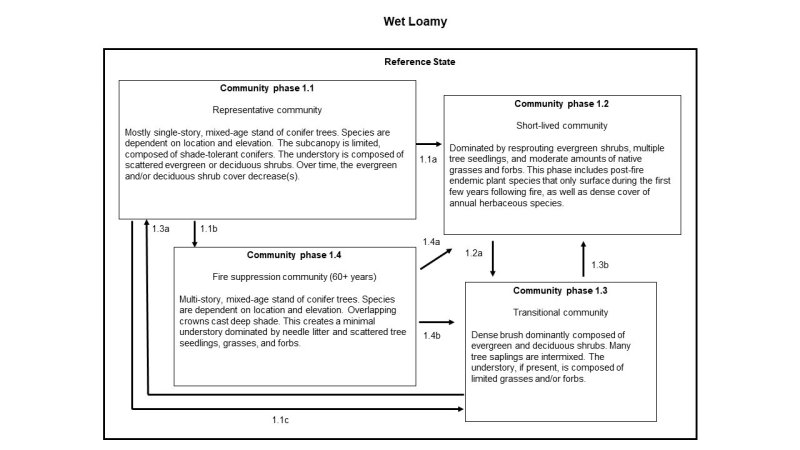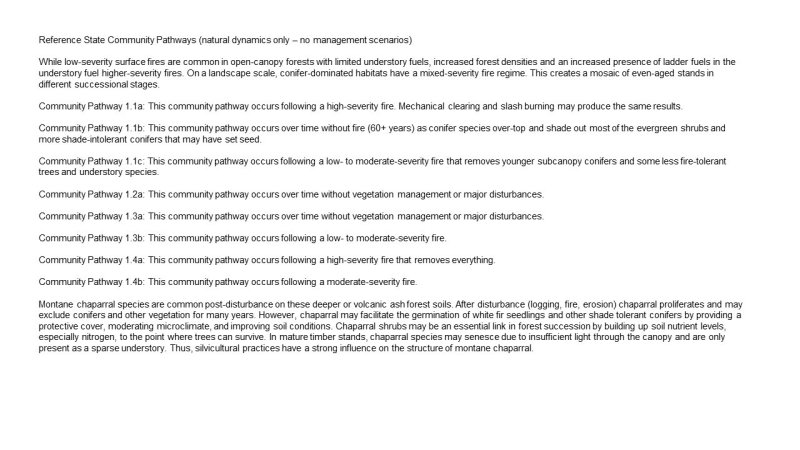Ecological site group F021XG914CA
Wet Loamy
Last updated: 08/26/2024
Accessed: 12/21/2025
Ecological site group description
Key Characteristics
- Upland sites
- > 30" ppt
- > 20" depth
- Loamy texture
Provisional. A provisional ecological site description has undergone quality control and quality assurance review. It contains a working state and transition model and enough information to identify the ecological site.
Physiography
This ESG is typically on mountain slopes, plateaus, glacial outwash plains, hillslopes, and escarpments on lava plateaus with slopes from 1 to 60 percent at elevations of 1,350 to 2,100 meters. It is characterized by rugged, deeply dissected terrain with steep slopes due to extensive glaciation. It is throughout the mountain ranges of southwestern Oregon and northwestern California including the Scott, Salmon, Marble, and southern Siskiyou Mountains, and the Trinity Alps.
Climate
The average annual precipitation is typically 9 to 25 inches (241 to 635 millimeters). It is highest, up to 57 inches (1,450 millimeters), in small areas at high elevations on the western and southwestern edges of MLRA 21. Other high precipitation zones are in the scattered mountain ranges throughout the rest of this area. Most of the precipitation occurs as low or moderate intensity Pacific frontal storms in winter. At higher elevations, rain generally turns to snow. Snow may fall at lower elevations in winter but does not last. Summers are dry. The average annual temperature is 37 to 53 degrees F (3 to 12 degrees C). Average monthly temperature during the summer months is 57 to 72 degrees F (14 to 22 degrees C). Average monthly temperature during the winter months is 15 to 46 degrees F (-10 to 8 degrees C). The frost-free period is 70 to 185 days with an average of 130 days. In heavy snowpack years, snowfields may remain on north- and east-facing slopes above 1,850 meters through the summer.
Soil features
The soils for this ESG are typically moderately deep to very deep, and well drained. They formed in colluvium and mudflows from glacial outwash derived from volcanic rocks and volcanic ash. At higher elevations soils are predominantly Haploxerepts or Haploxerands and are generally very gravelly or cobbly. There are scattered areas of shallow unproductive soils (i.e., Haploxerepts, or Xeralfs overlying peridotite and serpentine bedrock). There are also extensive areas of more productive Alfisols and Mollisols.
Representative soils include the Woodcock series (medial-skeletal, amorphic, frigid Alfic Humic Haploxerands), Woodchopper series (fine, isotic, frigid Pachic Ultic Argixerolls), and Rogger series (loamy-skeletal, mixed, superactive, frigid Ultic Haploxerolls). Parent materials in most areas are ultramafic. There are also scattered areas with serpentinitic parent materials.
Vegetation dynamics
This ESG represents the loamy forested areas of MLRA 21 that receive over 30 inches (760 millimeters) of average precipitation. This area is best described using the California Wildlife Habitat Relationships System classification for the Klamath Mixed Conifer (KMC) habitat. The KMC habitat is typically composed of tall, dense to moderately open, needle-leaved evergreen forests with patches of broad-leaved evergreen and deciduous low trees and shrubs. On favorable mesic sites with little disturbance, the habitat is dominated by evergreen conifers up to 200 feet (60 meters) tall with a rich shrub layer and well-developed herbaceous layer. On xeric sites, the habitat is generally open, but very diverse forestland with a well-developed shrub layer.
The overstory is characterized by a mixture of conifers. Dominant conifers in the western portion of this habitat are white fir and Douglas-fir. In the east, dominant conifers are white fir, Douglas-fir, ponderosa pine, incense cedar, and sugar pine. Other conifers in the overstory include Shasta red fir, Sierra lodgepole pine, mountain hemlock, western white pine, knobcone pine, Jeffrey pine, and Brewer spruce. In a few isolated stands, relic conifers include Pacific silver fir, subalpine fir, Port Orford cedar, Alaska cedar, and Engelmann spruce. Occasional broad-leaved trees include bush chinquapin, canyon live oak, and California black oak. Pacific yew occurs as a small tree in the understory.
At higher elevations, red fir and mountain hemlock are more prevalent with occasional whitebark pine and foxtail pine. At lower elevations or on xeric sites, ponderosa pine increases and white fir and Douglas-fir decreases. Jeffrey pine is the principal overstory species on ultramafic soils and serpentine outcrops.
Dense forests have a very rich shrub layer including Sierra laurel, deer oak, dwarf rose, or thimbleberry. In open to moderately dense forests, shrub-size plants in the subcanopy include small individuals of overstory species, especially Shasta red fir and white fir, as well as bitter cherry, bush chinquapin, pinemat manzanita, prostrate ceanothus, huckleberry oak, hollyleaved barberry, greenleaf manzanita, dwarf rose, snowberry, and serviceberry. The herbaceous layer is well developed and includes twinflower, American trailplant, bride’s bonnet, western rattlesnake plantain, fragrant bedstraw, Chimaphila spp., Idaho fescue, and tufted pinegrass.
The early successional stage is typically dense montane chaparral originating from buried seed. This chaparral is dominated by manzanita, huckleberry oak, giant chinquapin, snowbrush ceanothus, and bitter cherry. This shrub stage is followed by a dense young-growth conifer forest stage. The KMC habitat goes through different successional stages following disturbance or manipulation than other types of mixed conifer. In general, these types are early-seral grassland, early-seral shrub, young- or second-growth conifer forest, and mature or old-growth conifer forest. The KMC has several plant communities that are considered climax plant communities; successful reproduction of the overstory species occurs in the understory, indicating that the communities are perpetuating themselves.
Some forest trees in the Siskiyou Mountains are several centuries old. Frequent fires were common, with older trees surviving intensive burns and continuing to dominate the upper levels of the tree strata. Portions of this habitat are stable for several centuries before natural disturbance restarts the process of succession. Many vegetative units exhibit stability despite frequent fires, evidenced by deep fire scars on old-growth conifers, and should be regarded as fire-adapted vegetation. Commonly the plant communities in these areas are 200 years old or younger. KMC communities in the eastern part of the MLRA are stable, with frequent lightning fires. KMC communities in the western part of the MLRA are usually burned enough to revert to the montane chaparral type.
Information directly copied from:
California Wildlife Habitat Relationships System
California Department of Fish and Game
California Interagency Wildlife Task Group
By Gary Benson
Major Land Resource Area
MLRA 021X
Klamath and Shasta Valleys and Basins
Stage
Provisional
Click on box and path labels to scroll to the respective text.

